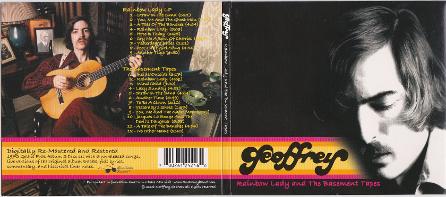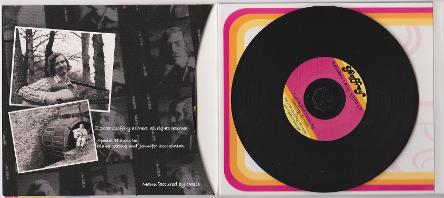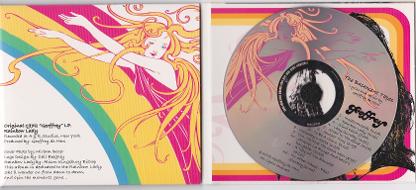


"Geoffrey - Rainbow Lady & The Basement Tapes " CD
The mystique around the rare gothic folk LP, "Geoffrey", which had limited pressing and release in 1972 (and more limited repressing in 1995) and which has been described as a "lost masterpiece", has only increased its desirability and value among collectors over the years.
...
Geoff de Mers' music has been described as "creative songwriting with innovative lyrical imagery" and his guitar playing style as "technically innovative" sometimes with "surprising vigor". He propels his songs with a "flurry of guitar styles - the music accompanies his vocals instead of just providing a backdrop". His songs are structurally "complex... yet simultaneously engaging in their emotional warmth".
...
Now the album has been completely digitally re-mastered and restored along with live recordings of previously unreleased songs and earlier live versions of tunes on the original LP. Also included with the 2 CD set is a 20 page booklet containing photographs, full lyrics, liner notes and historical commentary by the writer: Geoffrey - Rainbow Lady & The Basement Tapes
...
VARIETY magazine, June 21, 1972:
"Geoffrey (deMers), a young (25) singer-composer-guitarist from the Washington, DC area, is a promising folk-style performer making his Gotham debut at Kenny's Castaways [N.Y.C.] His delivery is sincere and his material shows some imagination, including 'Yesterday's Shoes' and 'Wind Child' ["Basement Tapes" CD]. The latter is introed as a hopeful dream. It is soft and touching. His 6 string guitar is mainly for support, sometimes with surprising vigor. His club style is easy. Geoffrey appears to have a bright future.
Kirb
01 Inside-Outside.mp3
03 Wind Child.mp3
04 Lazy Sunday.mp3
06 Another Time.mp3
07 To Be A Clown.mp3
10 Jacques La Rouges And The Devil's Daughter.mp3
11 Tale Of The Banshee.mp3
12 No Other Name.mp3
02 You, Me, and the Ghost Man(frm '72 LP) .mp3
09 You Me And The Ghost Man.mp3
03 A Tale of the Banshee, from '72 LP.mp3
04 Rainbow Lady, from '72 LP.mp3
01 Straw in the Sand, from '72 LP .mp3
07 Yesterday's Shoes, from '72 LP.mp3
06 Cry Me a Bowl of Cherries, from '72 LP .mp3
09 Another Time, from '72 LP.mp3
Matt Moses Article -1/28/06
A singer-songwriter needs something greater than the typical self-indulgent three-minute tune to distinguish himself from the hordes of Dylan aspirants. Technical innovation, creative songwriting and inventive lyrical imagery all help to elevate the solo performer. Geoffrey de Mers had these in spades, as his notoriously rare LP "Geoffrey" (Concert Arts, 1972) makes abundantly clear. Part Roy Harper, part Sandy Bull, the record contains a selection of long songs chronicling spiritual journeys matched with some shorter odes to mysterious romances.
...
Geoffrey propels his songs with a flurry of guitar styles - the music accompanies his vocals instead of just providing a backdrop. The songs can be alienating due to their complex structures and yet simultaneously engaging in their emotional warmth. Against his wishes, de Mers (b. 1947) started studying classical guitar at the age of ten. His mother, a concert pianist, tried to steer him toward classical music. He resisted somewhat but picked up a sense of composition that accompanies an academic understanding of this music. Of much greater interest were the newly emerging rock, R&B and folk music scenes, which
de Mers followed closely through the first few years of the 1960's. He began to write songs during a two-year stint at the University of New Hampshire, where he also played his first coffeehouse concerts. ["When I had my first coffeehouse performance at U.N.H. in 1967 one of the songs I performed was my own version of "Bells of Rhymney" by Pete Seeger, inspired by the Mitchell Trio's version as sung and played by their new replacement for Chad Mitchell (and the first and only ever guitar playing member), H.J. Deutschendorf, Jr. a.k.a. John Denver! I was so nervous! My fingers froze and got all hung up in the strings as I tried to play my fast, frenetic arrangement. From that time I started to learn to use finger picks so that I could play the steel strings with more precision and dynamics."]
...
His folk influences, including Judy Collins, Joan Baez, Eric Anderson, Gordon Lightfoot, Donovan and Simon and Garfunkel as well as Peter, Paul and Mary who de Mers cites time and time again, imply simplicity in songwriting completely absent from the songs on his record. It is, however, helpful to appreciate his intricate guitar work [as evolving out of his desire to] meld two lead parts into one and from his disciplined attempts to learn guitar parts note-perfect. ["During the years when I was attending boarding school in Indiana (Culver Military Academy, 1963 - 1967) I was already starting to develop my finger style ability. I was heavily into Peter, Paul & Mary at the time and learned various strumming and finger picking techniques by ear from the songs on their records. I remember struggling to learn the group's version of Bob Dylan's "Don't Think Twice" which was played with a rhythmic "Travis picking" finger technique. It was baffling to me and seemed amazing how the melody, bass and rhythm could all be played at the same time on one guitar...much as early blues finger picking styles were imitations of piano rag and boogie styles. I was attempting to combine Peter Yarrow's and Paul Stookey's guitar parts together into one as I was learning many of their tunes."]
However, as his forthcoming album would soon demonstrate, his songwriting style lands about as far from Peter, Paul and Mary as one could aim.
...
de Mers continued to develop his style and stayed abreast of developments in folk music throughout the late '60s and early '70s, especially Joni Mitchell, whose open guitar tunings had a strong influence on his songwriting. After leaving U.N.H. in 1969, de Mers
returned to the Washington, DC area where he continued a collaboration with his sister on the coffeehouse scene. "Theodora 'Thei' and I sang regularly at a coffeehouse in Washington called the "Iguana" which was a real happening place. It was the 'premiere' coffeehouse in Washington, really. There was a period of time when everybody who was anybody in the folk scene in Washington came through and played there."
...
de Mers then hooked up with Concert Arts, a small label nearby in Maryland. "I knew Chip Davidow who was the president of the company. When I found out that he was involved with promoting and that he had his little label and so forth, I sought him out and courted him a little bit." Davidow was primarily interested in working with classical music, but the unique performance and songwriting appealed to him enough to commit to an album, which was released in 1972.
...
"A bold gatefold ..."
Recorded live in two-track stereo, the simplicity of the production stands in sharp contrast to the complexity of the performance. In this regard, it sounds much like a coffeehouse performance in which the minor technical flaws are simply part of the parcel. To capture this music using state of the art recording technology would do it a disservice, pushing it toward the crisp insincerity associated with slick mainstream artists.
...
"And a wistful back cover."
Of the eight songs on the album, only one clocks in at under three minutes, the conspicuously nostalgic "Yesterday's Shoes." On the other end of the spectrum lies the epic "You, Me, and the Ghost Man," which just falls shy of the ten-minute mark. This standout track finds few points of concrete comparison; it shifts without notice from style to style, from one sequence of its ambling tale to another, without a readily evident structure. "That one was one of the quickest songs to come together. I had recently been up to New York and hadn't been there since I was a kid. I was so [struck by the unique atmosphere and character of the city], by [the multitude of] sights and sounds and by the hugeness of it all that I wanted to capture in music these images and feelings."
...
Other songs have a similar quality, such as "A Tale of the Banshee" which owes its distinct narrative style to traditional British folk music - like those imported and transposed by America's favorite folk trio - and to the mythologies of William Butler Yeats. " 'A Tale of the Banshee' came from my fascination with Irish folk music at the time. I had bought a book of Irish folk lore, written by William Butler Yeats, which included a description of a witchlike apparition called a banshee, the upper part of her body naked who would be seen pulling out her hair with a comb and wailing. She was accompanied by something called a 'Coach-a-Bower', drawn by black headless horses and which appeared as an omen of an impending death in the family. So, I just created my own story around Yeats' descriptions and used as inspiration memories from my childhood of the atmospheric Walt Disney movie 'Darby O' Gill and the Little People' starring Sean Connery. In the romantic lead role he actually sang a duet with the lovely Irish lass who starred opposite him as his love interest. And the film depiction of the black coach and headless horses seemed quite frightening to me at the time."
...
This influence of American popular culture makes de Mers' music distinct
from that of the British ballad interpreters of the day, who were aiming for a more accurate recreation of song styles past. "I think I had a Gothic flair. I enjoyed the idea that a song would tell a story: it would start at one point, then go through some processes and changes, and a transformation would occur within the song carrying it along a path to become something else, completing itself circularly where it began. And when you get to the end, you have a different feeling than you had when you started at the beginning. This is, in a sense, what happens with jazz music or classical composition, when you develop a theme and then redevelop it and go explore different directions with it. There was a period of time after this album when I got heavily into Celtic music. I bought the collection of Francis James Child's 'English and Scottish Popular Ballads', songs he collected in the 1800's and compiled into five volumes of books, all verses of songs handed down by word of mouth." Unlike the Child ballads, many of de Mers's lyrics avoid an overt narration, instead relying on more abstract imagery serving primarily to establish a mood.
...
When dealing with matters more personal, de Mers's open-ended lyrics
avoid the triteness that often accompanies overindulgent self-reflection. The album also contains a few love songs leaning mercifully toward the ambiguous, notably the plaintive "Rainbow Lady", to which the back cover art pays tribute. " 'Rainbow Lady' is a song
about a kind of dreamy hopefulness, [you know, the Irish promise of a pot of gold at the rainbow's end]. I wrote it with a particular relationship in mind but it's not so much about the one person [as about the fantasy, the idea, the unreal search for perfection]. I think a lot of the song came about from hope, as opposed to the sometimes unpleasant realities of life experience and searches for 'truth' in a love relationship." The song acts as a tribute to this romantic ideal, apparently fulfilled at the time by its subject but certainly open to change. Such is the ideal love song, sung ultimately not in tribute to the object of love but instead to love itself.
...
The closing cut, "Poor Little Girl Song," belongs to that scarce genre of tributes to an incarcerated lover (next to the Zombies' "Care of Cell 44"), opening with the tragic, if slightly corny, "Let me see your poor face through the prison bars". This and other cuts such as "Hope is Today" have a tone of blind optimism rarely present in singer-songwriter material (outside of the Contemporary Christian community). " 'Hope is Today' was the first song I wrote while I was at U.N.H. (I was writing it when I should have been studying) It was one of those ethereal, hopeful, naïve kind of things - [that 'blind hope' wasn't going to help me pass my exams]."
...
Paralleling the songs' thematic complexity, de Mers' music composition indicates well-trained and well-versed ears. His songs proved difficult to master, yet harder to remember. "I realized I had to practice hard to maintain some of these songs, because if I didn't practice every day, things would slip through the cracks. At the time, because I didn't know the correct names, I made up chord symbols, and my own names for the chords in order to remember the song arrangements."
...
Perhaps the best way to sum up is that this is an album of folk music that necessitates creative transcription, with a libretto penned by a Gothic poet. Due to the LP's limited pressing and promotion, the record failed to make de Mers a superstar - besides, in 1972, the charting musicians closest in spirit were Danny O'Keefe and Jonathan Edwards. He retreated for a few years to teach guitar, formed several folk groups along the way, until he met Meagan Lane in 1976. Together they founded 2nd Story, later to become the 2nd Story (World Beat Blues) Band, which perseveres to this day.
...
Due to the scarcity of the "Geoffrey" album, which today lists for upwards of $300 among collectors, few have been able to investigate this masterful work without a serious commitment to tracking a copy down only after putting a few treasured items in hock. A pointlessly limited repressing of the album a few years back only served to increase the
mystique around this lost masterpiece. Contemporary unreleased recordings exist on tape and acetate, so someone should get around to a proper re-release before erosion sets in on the masters.
Matt Moses